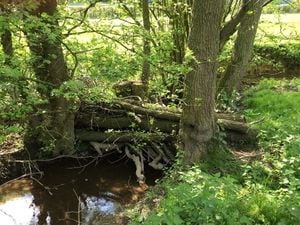Shropshire team show how beaver-like dams could help prevent flooding in future
The installation of around 600 leaky dams in south Shropshire could help reduce the scale of flooding, research has revealed.

Research into a six year project by Shropshire Council and the Shropshire Wildlife Trust has shown that their man-made 'leaky dams' held back millions of litres of water during storms.
Leaky dams can form naturally when large sections of trees fall into rivers and smaller sticks and leaves gather around the larger pieces of wood. While water can flow through the blockade, it works to hold back some of the water during high flows.
The dams also slow the movement of silt and sediment which could otherwise reduce the amount of space for water in streams and rivers.
The installation of around 600 man-made leaky dams in the River Corve and the surrounding rivers in south Shropshire took place between 2015 and 2021 as part of the 'Slow the Flow' partnership.
The partnership between Shropshire Council, Shropshire Wildlife Trust, the Environment Agency and the English Severn and Wye Regional Flood and Coastal Committee aimed to use natural methods - including leaky dams - to ‘slow the flow’ in a number of catchments and reduce flood risk to communities downstream.
Leaky dam data gathered by researchers at Cardiff University, partly funded by the Shropshire partnership, will help inform the planning and design stages of future flood risk management projects.
One of the key findings is that Natural Flood Management is a positive part of integrated flood management and has a role to play with other measures in reducing floods.
Luke Neal from the Shropshire Wildlife Trust said the research was a fundamental part of the project.
He said: "It's really important to have this research because we can quantify the impact of these structures and that means that we can deploy them in a way that we can effectively manage downstream flooding.
"This project has been really successful, partly because it's encouraged the roll-out of more natural flood management schemes.
"We're giving more people confidence that it's worth investing in and that it is working."





